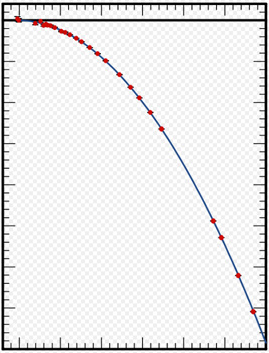|
For
over 50 years, physicists searched in vain for gravitational waves,
ripples in the fabric of spacetime predicted by Einstein’s theory of
general relativity — see my October 2016 newsletter.
In 1974, Hulse and Taylor published the first indirect
evidence of gravitational waves by precisely measuring the orbital
period of two neutron stars spiraling around one another. They showed
the orbital period decreased at exactly the rate Einstein predicted, as
their orbital energy was slowly carried away by gravitational waves.
 As
shown here, Einstein’s prediction (blue curve) is a stunning match to
the data (red dots) measured over a 30-year span ending in 2005. As
shown here, Einstein’s prediction (blue curve) is a stunning match to
the data (red dots) measured over a 30-year span ending in 2005.
Hulse and Taylor shared the 1993 Nobel Prize in Physics.
It took over 40 more years for the first direct detection of gravitational waves by LIGO.
Gravitational
waves are one of this century’s most exciting scientific discoveries.
The three LIGO principals — Barish and Thorne of Caltech and Weiss of
MIT — shared the 2017 Nobel Prize in Physics.
LIGO
in the U.S., and its partner VIRGO in Italy, detected 11 gravitational
wave events by the end of their second observing run in 2017. These
events comprised 10 BH/BH mergers (two black holes), and 1 NS/NS merger
(two neutron stars).
The
third observing run, with upgraded detectors, captured 21 events in its
first 4 months (through August 14, 2019). Preliminary analyses indicate
these comprise 18 BH/BH mergers, 2 NS/NS mergers, and 1 NS/BH merger.
While
LIGO/VIRGO will continue producing amazing results for many years,
these observatories have their limitations. LIGO’s size determines the
wave frequencies it can detect, and that determines what types of events
it finds. LIGO’s best sensitivity is between 30 and 1000 Hz (1 Hz is 1
cycle per second), which is optimal for mergers of black holes with
masses between 8 and 200 times the mass of our Sun.
As
exciting as LIGO is, we also want to observe mergers of supermassive
black holes (SMBHs) — the monsters lurking in the centers of major
galaxies, each of which can be 10 billion times more massive than our
Sun, or even more.
Galaxy
mergers are common in our universe. When galaxies merge, their central
SMBHs will eventually merge as well. The gravitational wave energy
released in a SMBH merger might be billions of times greater, for a
brief instant, than the light energy produced by all the stars in all
the galaxies in our universe — that we want to “see” !
The expected gravitational wave frequency for the merger of two SMBHs is 0.1
to 10 nanoHz, where 1 nanoHz is one full cycle every 1 billion seconds
(nearly 32 years). LIGO cannot possibly detect those mergers.
Is it possible to detect tiny waves that rise and fall only once every few decades?
NANOGrav
(the North American Nanohertz Observatory for Gravitational waves)
claims they can, and can do so “on the cheap”, by letting nature provide
most of the experimental “gear”.
NANOGrav is already monitoring the timing variations of 77 different pulsars.
Pulsars
are rapidly spinning neutron stars with immense magnetic fields that
sweep radio waves across the cosmos, much as lighthouses sweep light
beams across coastal waters. Every time a pulsar’s beam sweeps past
Earth, our radio telescopes detect a pulse. Some pulsars rotate nearly 1000 times per second.
An isolated pulsar can have an extremely stable pulse rate; some are stable to better than 1 part in a trillion.
For
15 years, NANOGrav has monitored an ever-growing list of pulsars using
the Green Banks and Arecibo radio telescopes. About twice a month, they
measure the pulse timing of each pulsar for about 20 minutes.
If
a gravitational wave passes through the space between Earth and a
pulsar, the distance between us changes by a tiny amount, perhaps as
much as 1 part in a 100 trillion. For a pulsar 1000 light-years away,
this changes the pulse arrival time by 300 micro-seconds. That change is
readily detectable, if it happens quickly. It is much more difficult to
detect if it happens gradually over decades. LIGO detects changes 1
billion times smaller, but which occur 100 billion times faster.
NANOGrav
is close, but not yet able, to detect such small changes over so many
years. With many more pulsars, longer observing periods, and faster
electronics, they believe their sensitivity can become 100 times better
by 2030.
With
200 monitored pulsars, they could reconstruct in 3-D how space
alternately expands and compresses as gravitational waves pass by, which
will also indicate where the waves come from.
As NANOGrav improves, their first expected discovery is a stochastic background
— the chaotic sum of all gravitational waves emitted by all
tightly-orbiting pairs of SMBHs in the entire universe. While waves from
each such source are small, and their sum too complex to unravel, their
total is detectable, much like static from a mistuned radio.
When
NANOGrav reaches its full sensitivity in 2030, it could detect
gravitational waves from individual SMBH mergers as far away as 5
billion light-years for SMBHs billions of times our Sun’s mass.
Since
NANOGrav will largely rent time on existing telescopes, their total
estimated cost is “only” $218 million over 10 years, 20% of LIGO’s total
cost since its first design work began 40 years ago.
I’ll let you know as soon as they’re done.

Best Regards,
Robert
Sept, 2019
Note: Previous newsletters can be found on my website.
|